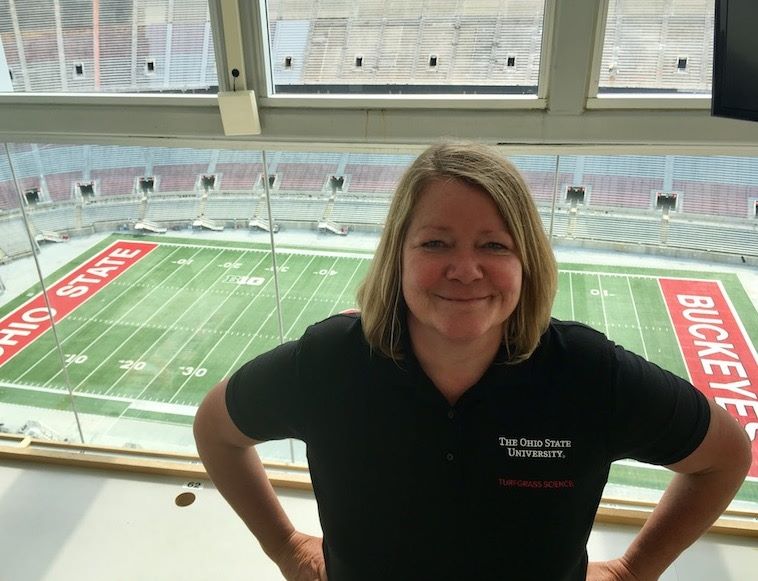Q: What are your thoughts on leaving the thatch after slice seeding? In the past we have lightly raked it up, but it is time-consuming. I see other companies leaving it behind. Will it adversely affect seed germination?
– Matt M.
A: On a native soil field, I don’t think there would be any detrimental effect to leaving the thatch/leaf debris on the surface, other than it looks unsightly for a few days. In fact, it might act as a mulch, keeping moisture locked in and preventing the seed from moving during a wind or rainstorm. If the debris layer is too thick though, it could adversely affect athlete and ball performance, and might impede light penetration.
It would not be acceptable to leave any kind of thatch debris on a sand-based field. Removing organic material from a sand-based surface is one of the key elements to sand-based field management, because the rate of organic matter accumulation exceeds the rate at which soil organisms can break it down. Also, the field surface needs to be free-draining and provide acceptable footing/traction for the athlete. Organic material left on the sand surface can produce a slick layer of biofilm or algae that creates a wet, slippery playing surface. Dr. Dave Minner coined the phrase “snot layer” to describe this phenomenon. When I wrote my thesis on organic matter control on hybrid turf systems, I preferred the term “hydrated clipping layer,” but I think Dave’s term captures the essence of it better.
Addressing this question from an agronomic standpoint, let’s look at what thatch is. Thatch is an organic layer composed of old grass roots, crowns, rhizomes and stolons that sit atop the soil surface. Leaf clippings do not contribute to thatch as they are 80% water and are broken down very quickly. Thatch takes longer to break down because it contains more organic carbon. When the lower layer of thatch (nearer to the soil surface) mixes with soil it forms a layer referred to as the “mat” layer. Mat is in a more advanced stage of decomposition than thatch, and retains more water and nutrients than thatch.
The rate of thatch accumulation in cool-season grasses varies by grass species. Creeping bentgrass produces more thatch than Kentucky bluegrass, which produces more than fine fescues > perennial ryegrass > tall fescue. Thatch buildup is also more likely to occur on compacted soils and low-traffic/impact areas such as endzones and outfields.
Both thatch and mat provide a cushion that creates a softer landing area for athletes. The thatch/mat layer also insulates the ground during cold weather and helps to retain moisture. However, a thatch layer greater than 1/2 inch can become soft and spongy and inhibit the infiltration of water, air and fertilizer into the underlying rootzone. Thatch can also attract insects such as cinch bugs, sod webworms and grubs, which in turn attracts skunks, racoons and crows.
Because thatch is rich in organic carbon, it can also inhibit the movement of pesticides into the underlying soil. Pesticide sorption by organic matter, and degradation of the pesticide by soil microbial populations in that organic matter, can have major effects on the efficacy of a pesticide product. Thatch will increase the pesticide degradation rate and reduce movement of immobile and moderately mobile pesticides. It may not have as much impact on more mobile pesticides. Thus, pesticides that need to be watered-in (such as insecticides) may be severely impeded by a thatch layer.
Thatch management is best performed by core aeration and either redistribution of soil cores (native fields) or topdressing (sand fields). This process dilutes the thatch with rootzone material and promotes biological degradation. Dethatching, scarifying or verticutting are mechanical removal practices that are commonplace, but they can cause stress to the turf in hot, dry weather, and they result in debris that needs removed. If the thatch layer is greater than 1 inch thick, a more aggressive coring, topdressing and dethatching program needs to be in place.
Pamela Sherratt is sports turf extension specialist at The Ohio State University.
Questions?
Send them to Pamela Sherratt at 202D Kottman Hall, 2001 Coffey Road, Columbus, OH 43210 or sherratt.1@osu.edu
Or send your question to Dr. Grady Miller, North Carolina State University, Box 7620, Raleigh, NC 27695-7620, or grady_miller@ncsu.edu


